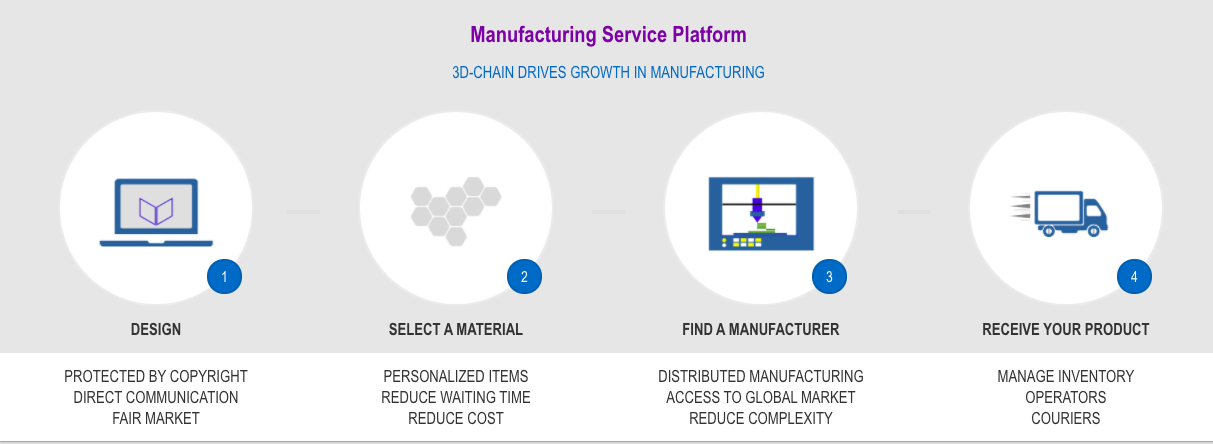Co-Founder of 3DChain, Babak Zareiyan, gives an outlook and explanation of the 3DChain concept, a unique manufacturing service platform for 3D printing.
You developed 3DChain, a design and additive manufacturing (AM) network. Can you tell us more about this interesting concept?
The challenges that come with AM in terms of production and decision making are numerous. Meeting these challenges has driven us here at 3DChain to create a new platform for future growth in production.
The founders of 3DChain are experts in AM, data science and machine learning. We introduced a decentralized marketplace that allows customers, designers, and manufacturers to join the ecosystem. 3DChain provides a framework to build digital assistants, at different levels of cognition, based on an AI model. 3DChain’s goals are developing and building innovation processes that prioritize global growth in the economy, unlocking mass customization, and decentralizing manufacturing to increase performance, reduce waiting time, and cost.
How do you relate a 3DChain for 3D printing service bureaus?
From the very beginning, we knew we did not want to simply create another database. Our goal was to provide a fresh take on 3D printing information; a more open and comprehensive data infrastructure that empowered users to explore connections between a wide range of data within the 3D printing domain.
We have created a database that offers the most comprehensive collection of linked data in a single platform including 3D printing technology, 3D printing materials, research and development, and 3D printing service providers. Because 3DChain maps the entire 3D printing lifecycle, you can follow production from design through post-processing to production.
Our platforms bring the value of new technologies to accelerate innovation, address cross-functional components in manufacturing (designer, manufacturer, customer, and supplier), develop a programmatic approach for supply chain, and set up a platform to bring new ideas and products to the market.
What specific services do you offer and what sectors have used the 3DChain for AM?
3DChain is a network of 3D printers in different sizes for scale variation in manufacturing, a decentralized network which provides a unique platform for 3D printing. The types of services are:
A 3D printing technology database that covers all 3D printer categories (desktop, professional, industrial).
A 3D printing material database that provides the most comprehensive materials database for 3D printing.
A 3D printing service database that provides a comprehensive and decentralized list of 3D printing companies to find suitable custom 3D printing service for products.
A research and development database that provides the connection between the 3D printing industry and research groups that leads to advancing opportunities.
What significant improvement can businesses or companies realize from using the 3DChain?
3DChain is highly focused on providing new growth opportunity for the manufacturing market. Our goals are increasing the adaptation range of new technologies, saving costs, reducing the risk of faulty designs, protecting copyrights, and expanding customized design and fabrication. 3DChain supports the software infrastructure for a sustainable merging of AM into a new, decentralized manufacturing market through evaluating customers, businesses, manufacturers, services providers, and suppliers.
Finally, how has the 3DChain helped in any way in fighting the COVID-19 pandemic?
The rate of economic growth in major economic blocks is declining and global manufacturing is facing fierce competition over market share. Neither building factories offshore to take advantage of the cheap labor nor expanding factories are solutions. A compelling solution is 3D printing, which can expedite the whole manufacturing process while decreasing cost. The 3DChain platform boosts productivity in the 3D printing industry and extends it to smarter and scalable products during and after the COVID-19 pandemic. It will create a micro economic shift and a new area of globalization, since the final product will be closer to the consumer, factories will be decentralized, and the focus will be on mass customization not mass production.
Subscribe to Our Email Newsletter
Stay up-to-date on all the latest news from the 3D printing industry and receive information and offers from third party vendors.
You May Also Like
New Report: Semiconductor Industry to See $1.4B in 3D Printing Revenues by 2032
“The semiconductor sector has become the most strategically significant area of global industry.” Truer words are hard to come by when it comes to the modern world, and they are...
Will Photonic-Crystal Lasers Revolutionize 3D Printing?
Powder bed fusion (PBF) for metals and polymers predominantly utilizes lasers as the primary heat source. Some directed energy deposition (DED) technologies also employ lasers, while various vat polymerization methods...
3D Printing Unpeeled: Orbex Investment, IndoMIM and HP, Ultrasonic Waves
INDO-MIM has bought three HP Metal Jet S100 printers, operating two in India and one in Texas. This is a win for HP because the company has deep experience in...
3D Printing Webinar and Event Roundup: April 21, 2024
It’s another busy week of webinars and events, starting with Hannover Messe in Germany and continuing with Metalcasting Congress, Chinaplas, TechBlick’s Innovation Festival, and more. Stratasys continues its advanced training...

































